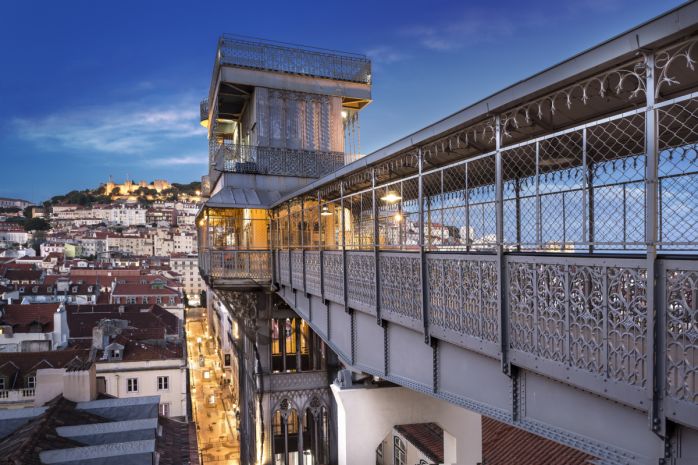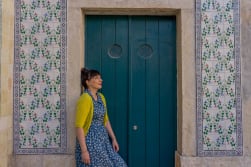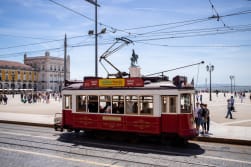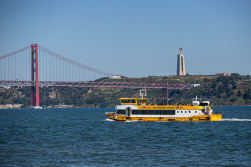Santa Justa lift & Lisbon funiculars
Lisbon is called the City of the Seven Hills, but some say there are more; we agree on one thing: climbing the hills is not easy, but at the end of each climb we are always surprised by magnificent views over the city.
The arrival of elevators in the city made it easier to go up to the higher districts, with the benefit of being able to contemplate daily life without taking your breath away, and all this aboard a vintage cabin that overflows with elegance.
At the end of the 19th century there were several elevators in the city, some of them with such long routes that they resembled the famous tramcars that we see today on rails. Of all these "lines" only three elevators and the impressive Santa Justa lift remain.

Santa Justa Lift
Opened in 1902, it is now a National Monument and one of the most visited in Lisbon. Built by Raoul Mesnier du Ponsard in neo-Gothic style, it has two cabins that go up 30 meters, from rua do Ouro, to a viewpoint, from where you can see Lisbon from the Tagus, the castle hill, the downtown, and even the top of the Eduardo VII’s park.
The upper platform also has a pedestrian connection to the Largo do Carmo where we find the grandiose Carmo Convent, from the 14th century/early 15th century in Gothic style. Its pointed arches no longer support the ceiling, which was destroyed after the 1755 earthquake. And right next door, the Carmo military headquarters of the general command of GNR, where Marcelo Caetano, Council President of the New State, took refuge and was arrested, marking the 25th of April Revolution and putting an end to the dictatorship that ruled Portugal since 1926.
The Santa Justa lift has 2 cabins that still work with its original mechanism and, among several curiosities, has a parachute system that has never been used. The iron and wooden lacework and the Gothic staircases give charm to this tower, where everyone wants to climb to discover the city's charms - and while you're at it, why not? - And why not make a trip to Largo do Carmo to taste the famous ginjinha liquor that can be found all over the city in its oldest cafes.
The hill it climbs: Chagas

Bica elevator
It’s the postcards’ favorite of Lisbon, for the views over the river, among the flowery buildings with wrought iron balconies. Also by Raoul Mesnier du Ponsard, it opened in 1892. It is also the two smallest elevator cabins in the city, which gives it a charming look. Originally, and like the other elevators, it worked by water counterweight, that is: when the upper cabin's tank filled up with water, the weight increased and made it go down to the lower level, simultaneously raising the lower cabin to the upper level, which was lighter because it had an empty tank. There was also a phase of steam locomotion, until the final transition to electric power. Nowadays, when one of the cabins is ready to move, a lamp lights in the other cabin to warn the driver, who prepares to start moving as well. The cabins meet halfway, and since they don’t move fast, there are passengers who even have time to chat a bit with their neighbors who walk by, side by side, on the sidewalk. At the São Paulo street terminal we find the beautiful Art Nouveau style entrance with tile-lined interior, and at the Calhariz street terminal, we find the funicular's operating machinery underground. In 2010, the artist Alexandre Farto (worldwide famous as Vhils, for his artistic interventions in urban buildings), as part of the Carris project "Art in Movement" (part of a program to support Portuguese Contemporary Art) made the coating of reflective metal film in the cabin of this elevator - and later, in 2013, a coating was made with a pattern illustrating the Portuguese cobblestone sidewalk.
The hill it climbs: Santa Catarina

Glória Elevator
From the top of the pleasant viewpoint of São Pedro de Alcântara, there is a cabin of the Glória elevator, ready to take us from the Bairro Alto area to the Avenida da Liberdade, more precisely to the Praça dos Restauradores, next to the Hard Rock Café. This elevator does not go straight up and down, it also curves and has an inclination of about 17%, so the trip becomes more impressive, but nothing to scare the most sensitive ones. It was opened in 1885, and initially had an Art Nouveau style terminal in the lower area (Avenida da Liberdade) which was later removed. The route along the Calçada da Glória is 265 meters long, and again among the curiosities that take part of these means of transportation, until the late nineteenth century, the cabins were illuminated by candles, during the night service.
The hill it climbs: São Roque

Lavra Elevator
Inaugurated in 1884, it is the oldest elevator in the city. It goes from Largo da Anunciada to Rua Câmara Pestana, and has an average inclination greater than the Glória elevator: 22.9%. It is discovered especially when you walk along Rua das Portas de Santo Antão, known for its many restaurants serving Portuguese cuisine, as well as for famous concert halls such as the Coliseu or the Politeama. It is, of all, the least popular elevator among visitors - and even among the city's inhabitants! - since it does not give access to any point identified as being of tourist interest. But for those with an explorer's soul, it is a unique part of the city, and there is also a viewpoint nearby that shows the city from a different perspective.
The hill it climbs: Santana
Curious about these vintage means of transportation?
With Yellowbus tickets, access is free and unlimited so you can live this experience, which just like the panoramic buses, Yellowboat or vintage streetcars, is a unique way to discover the city.









